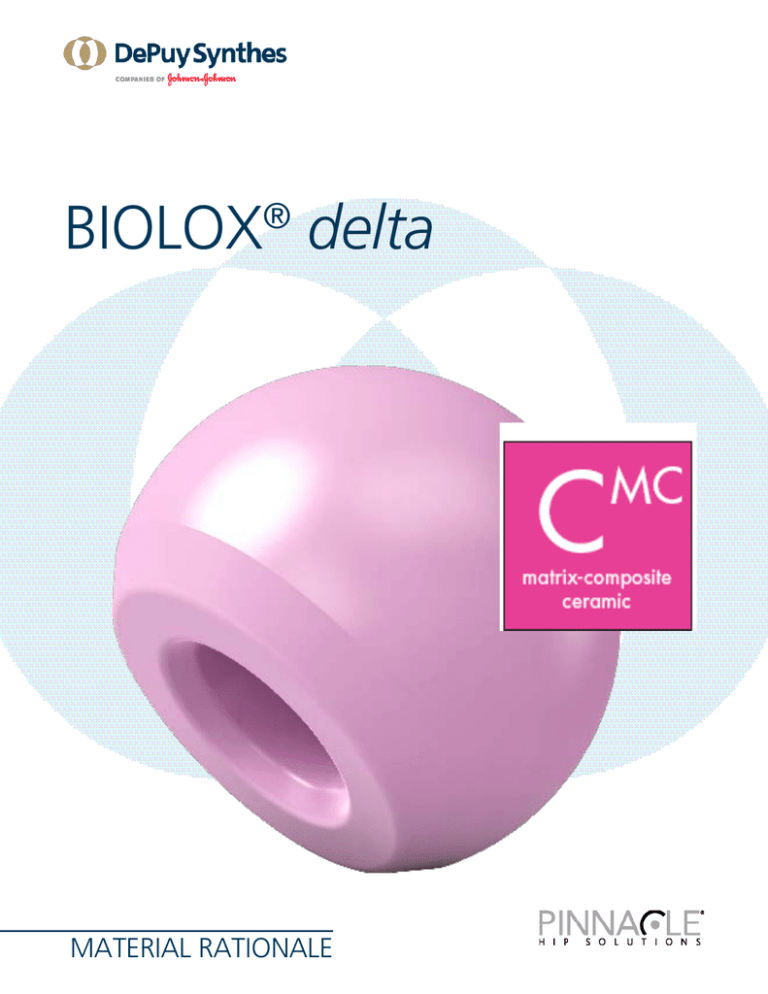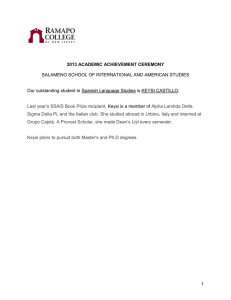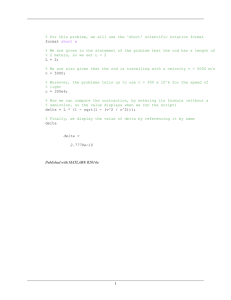
BIOLOX delta
®
MATERIAL RATIONALE
2 DePuy Synthes Joint Reconstruction BIOLOX® delta Material Rationale
INTRODUCTION
Alumina ceramic femoral heads have been used since the
1970s as an alternative bearing material in total hip
arthroplasty (THA). Alumina ceramic heads offer extreme
hardness, exacting sphericity, optimal clearance and
superior smoothness. With over 4 million ceramic ball
heads implanted worldwide, a significant amount of
clinical follow-up is available.1
While the clinical experience with alumina ceramic
femoral heads has been generally good, there have been
component fracture failures resulting from material issues
in first generation alumina ceramics. Incremental material
and processing changes have been implemented to
reduce this risk. The introduction of high purity,
chemically derived, sub-micron alumina powders — as
well as improved processing technologies, such as hot
isostatic pressing (HIPing) — has significantly improved
material properties of alumina ceramics. The current
generation of alumina material for orthopaedic
applications, BIOLOX® forte (CeramTec GmbH), has been
available since 1994.
While improvements to early alumina ceramics have been
significant, limitations in the mechanical properties of
pure alumina ceramics coupled with the higher demands
of today’s younger patients required the development of
an advanced ceramic material. The result of that
development is BIOLOX® delta Ceramic, manufactured by
CeramTec GmbH, a world leader in ceramics and the
leading company in the manufacturing of bioceramics for
orthopaedic applications.
BIOLOX® delta Material Rationale DePuy Synthes Joint Reconstruction 3
AN ADVANCED MATERIAL
BIOLOX delta is a zirconia-toughened, platelet-reinforced
generation ceramic materials. In zirconia-toughened
alumina ceramic (ZPTA), designed to incorporate the wear
alumina (ZTA) materials, some of the original hardness of
properties and stability of alumina with improved material
the alumina material is lost. The addition of chromium
strength and toughness and a distinctive color. BIOLOX
oxide imparts the material with its distinctive “mauve”
delta material contains approximately 82 percent alumina,
color. Finally, strontium oxide (SrO) added to the material
17 percent tetragonal zirconia particles, 0.5 percent
forms strontium aluminate platelets during the sintering
strontium aluminate, and 0.5 percent chromium oxide.
process. These platelets prevent microcracks in the material
All values are approximate values by volume composition.
from advancing by dissipating crack energy. This results in a
An alumina ceramic matrix provides BIOLOX delta with
increased hardness and material stability over previous
further increase of material strength and strength
distribution, as well as an increase in fracture toughness.1,2
Alumina matrix
Aluminum Oxide Particle
Zirconium Oxide Particle
Crack-stopping (SrAl) Platelet
Figure 1
The final product is a high-strength material with high hardness and
high toughness, a material well suited for applications in THA.
4 DePuy Synthes Joint Reconstruction BIOLOX® delta Material Rationale
MATERIAL PROPERTIES OF CERAMICS
Important characteristics of successful orthopaedic
implants include good mechanical performance, reliability
and wear resistance. These characteristics translate into
the engineering material properties of strength,
fracture toughness, stability and hardness.
• Strength refers to a material’s ability to withstand applied loads.
• Fracture toughness is a measure of a
material’s resistance to crack propagation
under stress.
• Stability
-- Chemical stability indicates a material’s
resistance to microstructural changes during the service life of the implant.
-- Hydrothermal stability indicates a material’s
resistance to change when exposed to elevated
temperatures and humidity.
• Hardness is the resistance of a material to deformation and relates to a material’s wear resistance.
The material properties listed above are controlled in ceramics
by managing material composition, density, porosity and grain size.
BIOLOX® delta Material Rationale DePuy Synthes Joint Reconstruction 5
STRENGTH
Strength refers to a material’s ability to withstand applied
a grain size less than 1.5 μm. Additionally, the zirconia par-
loads. Strength is controlled by the material grain size and
ticles in the matrix have a grain size of 0.2 – 0.6 μm.
sintered density. A reduction in grain size contributes to an
increase in strength.3 Advances in the manufacturing of
alumina ceramics have decreased the grain size considerably over early generation alumina ceramics. These advances have also increased density by reducing the material’s porosity. BIOLOX delta takes advantage of these
manufacturing advances and offers an alumina matrix with
One measure used to test the strength of a ceramic femoral head is a burst test, which measures the load required
to fracture a ceramic head assembled on a stem taper.
Due to their unique material composition, BIOLOX delta
Femoral Heads exhibit substantially improved burst
strength compared to early generation alumina ceramic
heads (See Figure 2 & Figure 3).2,3
Burst Strength2
Flexural Strength3
Figure 2
Figure 3
Strength refers to a material’s ability to withstand applied loads.
6 DePuy Synthes Joint Reconstruction BIOLOX® delta Material Rationale
FRACTURE TOUGHNESS
Fracture toughness is a measure of a material’s resis-
strontium oxide to the alumina matrix provides this in-
tance to crack propagation under stress. Metal and ce-
crease in fracture toughness to BIOLOX delta (Figure 4).
ramic implants exhibit scratches and microcracks as a result of polishing and finishing. Maximizing fracture
toughness reduces the opportunity for these scratches
and microcracks to propagate, potentially resulting in
component failure. The addition of zirconia particles and
Biolox delta Particle Reinforcement
Mechanism for Increased Fracture Toughness
Figure 4
In the event that a microcrack advances through the
material, the crack energy is dissipated by large grains
(mixed oxide platelets).
This increase in fracture toughness for the BIOLOX delta
material over pure alumina is shown in Figure 5 below.
The toughness is demonstrated in both the burst strength
and flexural strength of BIOLOX delta mentioned previously (Figure 2 & Figure 3).
Fracture Toughness3
Figure 5
Fracture toughness is a measure of a material’s resistance
to crack propagation under stress.
BIOLOX® delta Material Rationale DePuy Synthes Joint Reconstruction 7
STABILITY
Reliability is the extent to which a product yields the same
result on repeated uses; it is a measure of the predictability of a product’s performance. Two key factors for the
long term in vivo performance of ceramic implants are
chemical and hydrothermal stability.
Hydrothermal stability indicates a material’s resistance
to change when exposed to elevated temperatures and
humidity. BIOLOX delta is based on an alumina matrix.
Microstructurally, medical grade alumina is a single-phase
material and therefore offers excellent phase stability.
Chemical stability indicates a material’s resistance to
microstructural changes during the service life of the implant. Oxide ceramics (alumina and zirconia) are well
known and accepted in biomedical applications with respect to their chemical stability and biocompatibility.
These ceramics exhibit corrosion resistance in vivo. In addition, the biocompatibility of oxide ceramic bulk materials
and particulate debris has been demonstrated through
years of clinical use.
In contrast, zirconia ceramic is a complex, multi-phase material. One benefit of this material, if manufactured appropriately, is increased fracture toughness through a process
called “transformation toughening.” If a microcrack in the
material reaches a tetragonal phase particle, a phase
transformation changes the zirconia particle from a tetragonal to a monoclinic state, where the particle increases in volume approximately 3 to 4 percent. The resulting increase in volume can close the microcrack,
making the material more fracture resistant (Figure 6).
BIOLOX delta transformation toughening mechanism for increased fracture toughness
If the leading edge of a microcrack encounters
a tetragonal zirconia particle, the crack energy
causes a phase transformation, increasing the
particle volume and closing the crack tip.
A metastable zirconia particle maintains its
tetragonal phase due to compressive forces
within the surrounding alumina matrix.
Figure 6
Chemical stability indicates a material’s resistance
to microstructural changes during the service life of the implant.
8 DePuy Synthes Joint Reconstruction BIOLOX® delta Material Rationale
Under some hydrothermal conditions (elevated heat and
humidity) an uncontrolled phase transformation of zirconia
ceramics can occur. An uncontrolled phase transformation
affects multiple particles simultaneously, creating internal
strains and reducing material strength.5
The distribution of the zirconia particles allows the benefits of transformation toughening to close microcracks,
but because the zirconia particles do not share grain
boundaries with each other, a chain effect of transforma-
tion is prevented. Compressive forces within the alumina
matrix prevent an uncontrolled phase transformation of
the zirconia particles in the absence of a microcrack because there is no room for volume expansion.
BIOLOX delta benefits from the improved strength of
transformation toughening, while maintaining hydrothermal stability. Multiple cycles in an autoclave show no degradation in the mechanical strength of the material, as
compared to a non-sterile control.7
Material Stability6
Figure 7
Hydrothermal stability indicates a material’s resistance to change
when exposed to elevated temperatures and humidity.
BIOLOX® delta Material Rationale DePuy Synthes Joint Reconstruction 9
HARDNESS
Hardness is the resistance of a material to deformation
BIOLOX delta Ceramic offers a material hardness of about
and relates to a material’s wear resistance. In order to
2000 HV, nearly as hard as diamond (Figure 8).3,4,7
minimize wear at the articular surface of a total hip
replacement, it is essential to use femoral heads with a
smooth surface finish. An exceptionally smooth surface
can be achieved with high hardness materials such as
BIOLOX delta through precise polishing processes. The
In addition, this high level of hardness can provide
substantial resistance to surface scratching from third
body particulate and the potential for wear reduction
benefits in vivo.
Material Hardness3,4,7
Figure 8
Hardness is the resistance of a material to deformation
and relates to a material’s wear resistance.
11 DePuy Synthes Joint Reconstruction BIOLOX® delta Material Rationale
TESTING
All BIOLOX delta Ceramic Femoral Heads are 100 percent
manufacturing process. Product characteristics such as
Proof Tested. Each femoral head produced is subjected to
chemical composition, microstructure (grain size, density,
an overload in a manner that ensures the part is not
homogenous distribution of elements), surface finish and
damaged in any way, yet minimizes the possibility of an
dimensional compliance are inspected to ensure design
internal flaw not being discovered. The Proof Test is only
specifications are consistently met (Figure 9). This standard
part of an entire quality system, which performs several
of quality provides high product reliability.
specific and ongoing checks throughout the entire
BIOLOX - Comparison of Three Generations1
BIOLOX® (since 1974)
VARIABLE
UNIT
Al2O3
BIOLOX®forte (since 1995)
BIOLOX®delta (since 2004)
AVERAGE
VARIANCE
AVERAGE
VARIANCE
AVERAGE
VARIANCE
Vol.-%
99.7
0.15
>99.8
0.14
81.6
0.17
ZrO2
Vol.-%
n.a.
–
n.a.
–
17
0.1
Other oxides
Vol.-%
Rest
–
Rest
n.a.
1.4
0.01
Density
g/cm3
3.95
0.01
3.97
0.00
4.37
0.01
Grain size Al2O3
μm
4
023
1.750
0.076
0.560
0.036
4-point bending strength*
MPa
500
45
631
38
1384
67
E-module
GPa
410
1
407
1
358
1
Fracture toughness KIc **
MPa m1⁄2
3.0
0.45
3.2
0.4
6.5
0.3
Hardness HV1
GPa
20
–
20
–
19
–
* Average values measured for BIOLOX delta from 2006.
** Fracture toughness refers to the capacity of a material to resist crack propagation; K lc is the corresponding characteristic value.
Figure 9
BIOLOX® delta Material Rationale DePuy Synthes Joint Reconstruction 11
References
1. CeramTec Gmbh. The fourth generation of ceramics: Scientific information and performance data. Biolox delta –
Nanocomposite for Arthoplasty. http://www.ceramtec.com/files/mt_biolox_delta_en.pdf
2. Burger, W. and H.G. Richter. “High Strength and Toughness Alumina Matrix Composites by Transformation Toughening
and ‘In Situ’ Platelet Reinforcement (ZPTA) — The New Generation of Bioceramics.” Proceedings of the 13th International
Symposium on Ceramics in Medicine, Bologna, Italy: Trans Tech Publications, Nov. 22-26, 2000: 545-548.
3. Jeffers JRT, Walter WL. Ceramic-on-ceramic bearings in hip arthroplasty: State of the art and the future. Journal of Bone &
Joint Surgery June 2012; 735-745.
4. Rack, R. and H.G. Pfaff. “A New Ceramic Material for Orthopedics.” Proceedings of the 5th International CeramTec
Symposium, G. Thieme Verlag, Stuttgart, 2000: 141-145.
5. Rack, R. and H.G. Pfaff. “Long-term Performance of the Alumina Matrix Composite BIOLOX delta.” Proceedings from the
6th International BIOLOX Symposium 2001.
6. CeramTec - Test Report 2510 Burst Strength of BIOLOX® delta Ball Heads after Sterilization in the Autoclave
7. Heros, Ricardo J. and Gerd Willman. “Ceramics in Total Hip Arthroplasty: History, Mechanical Properties, Clinical Results
and Current Manufacturing State of the Art.” Seminars in Arthroplasty, April 1998: 114-122.
BIOLOX® is a registered trademark of CeramTec GmbH
Limited Warranty and Disclaimer: DePuy Synthes Joint Reconstruction products are sold with a limited warranty to the original purchaser against defects
in workmanship and materials. Any other express or implied warranties, including warranties of merchantability or fitness, are hereby disclaimed.
WARNING: In the USA, this product has labeling limitations. See package insert for complete information.
CAUTION: U
SA Law restricts these devices to sale by or on the order of a physician.
Not all products are currently available in all markets.
DePuy Orthopaedics, Inc.
700 Orthopaedic Drive
Warsaw, IN 46582
USA
Tel: +1 (800) 366-8143
Fax:+1 (800) 669-2530
www.depuysynthes.com
© DePuy Synthes 2015. All rights reserved.
DSUS/JRC/0415/0807(1) EO 06/15



